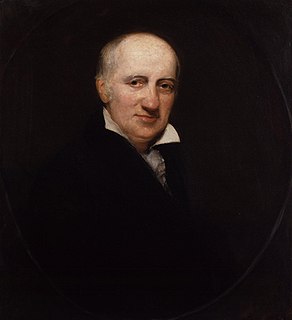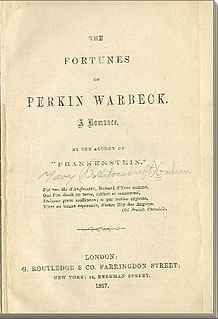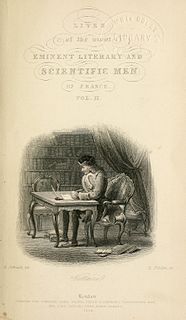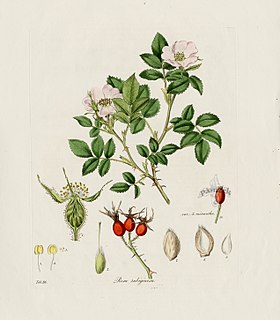Plot and themes
In Lodore, Shelley focused her theme of power and responsibility on the microcosm of the family. [2] The central story follows the fortunes of the wife and daughter of the title character, Lord Lodore, who is killed in a duel at the end of the first volume, leaving a trail of legal, financial, and familial obstacles for the two "heroines" to negotiate. Mary Shelley places female characters at the centre of the ensuing narratives: Lodore's daughter, Ethel, raised to be over-dependent on paternal control; his estranged wife, Cornelia, preoccupied with the norms and appearances of aristocratic society; and the intellectual and independent Fanny Derham, with whom both are contrasted. [3]
Aristocracy is a form of government that places strength in the hands of a small, privileged ruling class. The term derives from the Greek aristokratia, meaning "rule of the best-born".
The novel's modern editor, Lisa Vargo, has noted the text's engagement with political and ideological issues, particularly the education and social role of women. [4] She suggests that Lodore dissects a patriarchal culture that separated the sexes and pressured women into dependence on men. [5] In the view of critic Betty T. Bennett, "the novel proposes egalitarian educational paradigms for women and men, which would bring social justice as well as the spiritual and intellectual means by which to meet the challenges life invariably brings". [6]

The Last Man is a post-apocalyptic science fiction novel by Mary Shelley, which was first published in 1826. The book tells of a future world that has been ravaged by a plague. The novel was harshly reviewed at the time, and, except for a 1924 silent film based on it, was virtually unknown – having been eclipsed by Shelley's more popular works – until a scholarly revival in the 1960s. It is notable in part for its semi-biographical portraits of Romantic figures in Shelley's circle, particularly Shelley's late husband Percy Bysshe Shelley and Lord Byron.

William Godwin was an English journalist, political philosopher and novelist. He is considered one of the first exponents of utilitarianism and the first modern proponent of anarchism. Godwin is most famous for two books that he published within the space of a year: An Enquiry Concerning Political Justice, an attack on political institutions, and Things as They Are; or, The Adventures of Caleb Williams, an early mystery novel which attacks aristocratic privilege. Based on the success of both, Godwin featured prominently in the radical circles of London in the 1790s. He wrote prolifically in the genres of novels, history and demography throughout his lifetime.
Mathilda, or Matilda, is the second long work of fiction of Mary Shelley, written between August 1819 and February 1820 and first published posthumously in 1959. It deals with common Romantic themes of incest and suicide. The narrative deals with a father's incestuous love for his daughter.

Mary: A Fiction is the only complete novel by 18th-century British feminist Mary Wollstonecraft. It tells the tragic story of a female's successive "romantic friendships" with a woman and a man. Composed while Wollstonecraft was a governess in Ireland, the novel was published in 1788 shortly after her summary dismissal and her decision to embark on a writing career, a precarious and disreputable profession for women in 18th-century Britain.

Valperga: or, the Life and Adventures of Castruccio, Prince of Lucca is an 1823 historical novel by the Romantic novelist Mary Shelley, set amongst the wars of the Guelphs and Ghibellines.

The Fortunes of Perkin Warbeck: A Romance is an 1830 historical novel by Mary Shelley about the life of Perkin Warbeck. The book takes a Yorkist point of view and proceeds from the conceit that Perkin Warbeck died in childhood and the supposed impostor was indeed Richard of Shrewsbury. Henry VII of England is repeatedly described as a "fiend" who hates Elizabeth of York, his wife and Richard's sister, and the future Henry VIII, mentioned only twice in the novel, is a vile youth who abuses dogs. Her preface establishes that records of the Tower of London, as well as the histories of Edward Hall, Raphael Holinshed, and Francis Bacon, the letters of Sir John Ramsay to Henry VII that are printed in the Appendix to John Pinkerton's History of Scotland establish this as fact. Each chapter opens with a quotation. The entire book is prefaced with a quotation in French by Georges Chastellain and Jean Molinet.

Frances "Fanny" Imlay, also known as Fanny Godwin and Frances Wollstonecraft, was the illegitimate daughter of the British feminist Mary Wollstonecraft and the American commercial speculator and diplomat Gilbert Imlay. Wollstonecraft wrote about her frequently in her later works. Fanny grew up in the household of anarchist political philosopher William Godwin, the widower of her mother, with his second wife and their combined family of five children. Fanny's half-sister Mary grew up to write Frankenstein and married Percy Bysshe Shelley, a leading Romantic poet, who composed a poem on Fanny's death.

Part of what made reform possible in Britain in the second half of the eighteenth century was the dramatic increase in publishing; books, periodicals, and pamphlets became much more widely available than they had been just a few decades earlier. This increase in available printed material helped facilitate the rise of the British middle class. Reacting against what they viewed as aristocratic decadence, the new professional middle classes, offered their own ethical code: reason, meritocracy, self-reliance, religious toleration, free inquiry, free enterprise, and hard work. They set these values against what they perceived as the superstition and unreason of the poor and the prejudices, censorship, and self-indulgence of the rich. They also helped establish what has come to be called the "cult of domesticity", which solidified gender roles for men and women. This new vision of society rested on the writings of Scottish Enlightenment philosophers such as Adam Smith, who had developed a theory of social progress founded on sympathy and sensibility. A partial critique of the rationalist Enlightenment, these theories promoted a combination of reason and feeling that enabled women to enter the public sphere because of their keen moral sense. Wollstonecraft's writings stand at the nexus of all of these changes. Her educational works, such as her children's book Original Stories from Real Life (1788), helped inculcate middle-class values, and her two Vindications, A Vindication of the Rights of Men (1790) and A Vindication of the Rights of Woman (1792), argue for the value of an educated, rational populace, specifically one that includes women. In her two novels, Mary: A Fiction and Maria: or, The Wrongs of Woman, she explores the ramifications of sensibility for women.
Falkner (1837) is the second to last novel published by the author Mary Shelley.

The Lives of the Most Eminent Literary and Scientific Men comprised ten volumes of Dionysius Lardner's 133-volume Cabinet Cyclopaedia (1829–46). Aimed at the self-educating middle class, this encyclopedia was written during the 19th-century literary revolution in Britain that encouraged more people to read.

"Maurice, or the Fisher's Cot" is a children's story by the Romantic writer Mary Shelley. Written in 1820 for Laurette Tighe, a daughter of her friends Margaret King and George William Tighe, Mary Shelley tried to have it published by her father, William Godwin, but he refused. The text was lost until 1997, when a manuscript copy was discovered in Italy.

Frankenstein; or, The Modern Prometheus is a novel written by English author Mary Shelley (1797–1851) that tells the story of Victor Frankenstein, a young scientist who creates a hideous, sapient creature in an unorthodox scientific experiment. Shelley started writing the story when she was 18, and the first edition of the novel was published anonymously in London on 1 January 1818, when she was 20. Her name first appeared on the second edition, published in 1823.

St. Irvyne; or, The Rosicrucian: A Romance is a Gothic horror novel written by Percy Bysshe Shelley in 1810 and published by John Joseph Stockdale in December of that year, dated 1811, in London anonymously as "by a Gentleman of the University of Oxford" while the author was an undergraduate. The main character is Wolfstein, a solitary wanderer, who encounters Ginotti, an alchemist of the Rosicrucian or Rose Cross Order who seeks to impart the secret of immortality. The book was reprinted in 1822 by Stockdale and in 1840 in The Romancist and the Novelist's Library: The Best Works of the Best Authors, Vol. III, edited by William Hazlitt. The novella was a follow-up to Shelley's first prose work, Zastrozzi, published earlier in 1810. St. Irvyne was republished in 1986 by Oxford University Press as part of the World's Classics series along with Zastrozzi and in 2002 by Broadview Press.

Presumption; or, the Fate of Frankenstein is an 1823 play in three acts by Richard Brinsley Peake based on the novel Frankenstein; or, The Modern Prometheus by Mary Shelley. It is the first recorded theatrical adaptation of the novel and had 37 performances during its original run. It was revived at the English Opera House until at least 1850.

Frances "Fanny" Blood was an English illustrator and educator and longtime friend of Mary Wollstonecraft.

The Frankenstein authorship question refers to the historical uncertainty that existed around Percy Bysshe Shelley's contributions to
Frankenstein; or, The Modern Prometheus, a novel attributed to Shelley's wife, Mary Shelley.

"On Frankenstein" is a review of the 1818 novel Frankenstein; or, The Modern Prometheus written by Percy Bysshe Shelley in 1817 but not published until 1832.






















